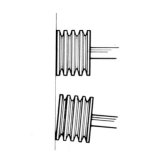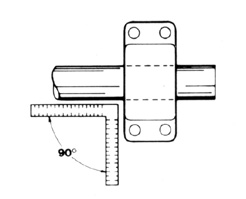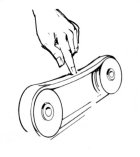|
THE FAN DOCTOR
|
|
|
Most industrial fans are very reliable, designed by knowledgeable
manufacturers for long life under a multitude of conditions. However, breakdowns
do happen. They can be caused by incorrect installation, lack of maintenance or
even improper fan selection. It can also be that years of strenuous service have
simply worn out the fan.
This page is presented as a guide, and not a technical service manual, more complex
causes and remedies are not included. Remember also that some ailments may have
more than one cause.
If you don't find the answer to your question here, please complete the help request
at the bottom of this page. Your request will be answered promptly by a qualified
Chicago Blower service technician.
|
|
|
|
| Vibration |
Noise | Overheated Bearings |
Poor Air Performance | Ask The Fan Doctor
|
|
|
|
|
Vibration
|
|
Cause
|
Remedy
|
|
The most common cause of vibration problems is out of
balance fan wheel or rotor.
|
Check the wheel for any dirt or foreign material, especially
hard-to-see places like the backside of the wheel and the underside of the blades.
|
|
|
|
Airfoil blades are usually hollow. When exposed to rain
or excessive moisture, they can get water inside of them. Drilling one 3/16"
drain hole in the upper surface of each blade near the trailing edge should cure
the problem. Rebalancing is not usually necessary.
|

|
|
|
|
Inspect the wheel for corrosion or erosion. Usually wheel
erosion will occur at the leading edge of the blade. On a paddle wheel type fan
the outer blade tip may also be worn. An airfoil wheel exposed to sand or abrasive
dust can actually develop pin holes in the leading edge of the blades. Do all possible
to eliminate these damaging conditions and then rebalance the wheel. If the wheel
is seriously damaged, it will have to be replaced.
|
|
|
|
|
Improper or loose mounting.
|
Foundation bolts and bearing mounting bolts can loosen
themselves. Make sure they are tight.
|
|
|
|
|
Loose set screws that hold the wheel to the shaft.
|
Again, tighten the screws, but first be certain the wheel
hasn't shifted on the shaft or is rubbing on the inlet cone or drive side of the
housing.
|
|
|
|
|
Bent fan shaft.
|
First, check the shaft with a dial indicator. If bent,
it should be replaced as soon as possible to avoid replacing the entire fan.
|
|
|
|
|
Misaligned V-belt drive, another very common problem on
belt driven fans.
|
Realign assembly so fan and motor shaft are parallel and
faces of sheaves (pulleys) are flush to a straight edge. We've found that a taut
string will work fine.
|

|
|
|
|
|
Fan wheel turbulence due to the rotor running backwards.
|
Since blade angles and shapes vary greatly, it is easy
to misread rotor direction. Check for correct wheel rotation, clockwise or counter
clockwise, as seen from the drive side. We illustrate the correct rotation for various
wheel types in CBC Course 100, page 4.
|
|
|
|
|
Air pulsation.
|
Fan may be operating in the stall area of its performance
curve. That means it is oversized for your particular system - refer to CBC
Course 100, paragraph 3.22 - or the system resistance is higher than intended.
You can lower the system resistance by cleaning the filters or opening the dampers.
|
|
|
|
|
Can't find the answer to your problem? Ask The
Fan Doctor.
|
|
|
|
|
Noise
|
|
Cause
|
Remedy
|
|
Foreign material in the fan housing.
|
This could be anything from a loosened bolt to somebody's
lunch bag. Inspect the wheel and inside of fan housing and clean thoroughly.
|
|
|
|
|
Squealing V-belts.
|
Belts are either loose or misaligned. If belts show wear,
you are better off to replace them now and avoid a future breakdown.
|
|
|
|
|
Worn ball or roller bearings. (Howling, screeching, or
clicking).
|
Change the bearings immediately before they cause additional
damage. Failing bearings tend to wear the shaft, so you want to be absolutely certain
the shaft is full size before installing these new bearings. "Mike" the
shaft both under the bearing and next to it and compare the two readings. If they
do not match, replace the shaft. New bearings installed on a worn shaft will not
last long.
|
|
|
|
|
Bearing seal misaligned. (High pitch squeal).
|
Realign the face of the bearing so that it is perpendicular
to the shaft.
|

|
|
|
|
|
If the fan housing has a metal shaft seal it could be misaligned
and rubbing on the shaft.
|
Loosen seal plate bolts, re-center the seal on the fan
shaft and tighten the bolts. If the seal is fiberglass, cork or rubber, be sure
the metal backing plate does not touch the shaft.
|
|
|
|
|
Can't find the
answer to your problem? Ask
The Fan Doctor.
|
|
|
|
|
Overheated
Bearings
|
|
Ball or roller bearings tend to heat up when they have
been over greased and will cool down to their normal running level when the excess
grease oozes out. The normal operating temperature of a bearing may be well above
140°F which is hot to touch. Temperatures above this have to be read with instruments
and anything above 180°F should be questioned. If you place a drop of water on the
bearing and it sizzles, the bearing is in distress and should be changed before
it seizes and ruins the shaft.
|
|
|
|
|
Cause
|
Remedy
|
|
Bearing may be worn and failing.
|
Replace the bearings. Remember to also check the shaft.
(refer back to Noise section)
|
|
|
|
|
Improper grease.
|
Use a lithium base, high speed, channeling type grease.
Do not use high temperature or general purpose grease.
|
|
|
|
|
Over greasing.
|
If you allow the bearing to run for a few hours, it will
normally purge itself of the extra grease. You can simply remove excess grease from
split roller bearings by lifting the top half of the block for access.
|
|
|
|
|
Bearing exposed to "heat soak" from an oven or
dryer after shutdown.
|
"Heat soak" occurs when a fan is idle and its
shaft cooling wheel can no longer cool the inboard bearing. Heat from inside the
fan can actually cook the grease. A 15 minute fan run after the oven heat is turned
off will cool the fan shaft and protect the bearing.
|
|
|
|
|
Loose V-belts may cause belt slippage and friction heating
resulting in hot bearings, shafts or sheaves.
|
Tighten belt to proper tension. A good rule of thumb -
you should be able to depress the belt the same distance as the thickness of the
belt.
|

|
|
|
|
|
Excessive V-belt tension.
|
Belts may be too tight. Adjust to the correct tension.
|
|
|
|
|
Can't find the
answer to your problem? Ask
The Fan Doctor.
|
|
|
|
|
Poor Air
Performance
|
|
Cause
|
Remedy
|
|
Fan rotation incorrect.
|
Refer to Vibration section. An
easy way to change rotation on most 3-phase motors is to reverse any two motor leads.
|
|
|
|
|
Abrupt turn in the duct close to the fan discharge or air
pre-spin caused by ductwork elbows at the inlet.
|
Install turning vanes or elbow splitters in the duct. If
air performance is still inadequate, the discharge position may have to be changed.
|
|
|
|
|
If fan has an Inlet Volume Control (IVC), is it improperly
installed?
|
Be sure the IVC is installed with pre-spin of the air in
direction of wheel rotation when the IVC is partially closed.
|

|
|
|
|
|
Off-center wheel.
|
This can occur on double width, double inlet fans. Center
the fan between the inlet cones to avoid overloading one side of the wheel while
starving the other.
|
|
|
|
|
Fan horsepower unexpectedly low.
|
Correct one or more of the following conditions:
Air pre-spin into the fan inlet
Fan drive sheaves set for too low a fan speed
Resistance to airflow, such as caused by a closed damper, much higher than calculated
|
|
|
|
|
Fan horsepower unexpectedly high.
|
Be sure fan speed is not too high. Fan may be operating
without ductwork at low resistance so that too much air is flowing.
The fan may be handling ambient air when it was originally intended for hot, less
dense air.
Fan may be running backwards.
|
|
|
|
|
Can't find the
answer to your problem? Ask
The Fan Doctor.
|
|
|
|
|
Ask The Fan
Doctor
|
|
|
|
|
|
|
|